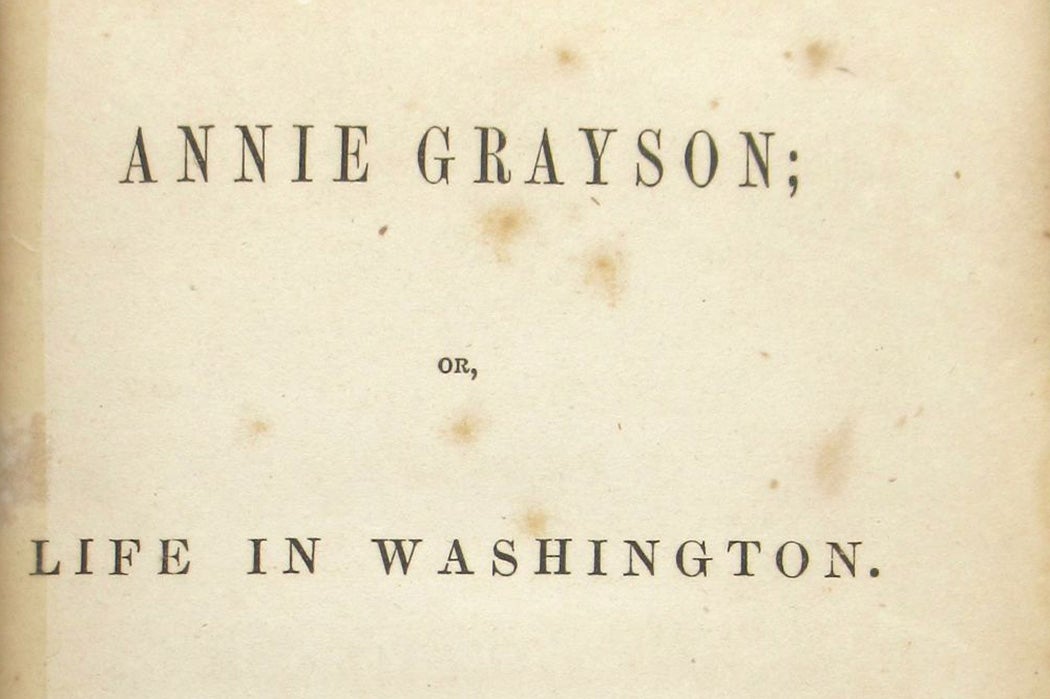Henry Adams’s 1880 Democracy is sometimes called the first “Washington novel,” but Nancy Polke Lasselle had Adams beat by a couple decades. Her two novels on the political and social doings in the capital predate the Civil War. Though the war radically transformed the District of Columbia, her view of an antebellum society “enmeshed in the machinery of government” as John G. Kester puts it, still sounds… kind of familiar.
There are a tarnal [damned] sight of smart fellows sent to Congress, who have not one mite of principle. And when they get there, all they do, is to manage and bargain for their own advancement, never thinking of their constituents till they want their votes to re-elect them.” — from Annie Grayson; or, Life in Washington (1853)
It is a waste of breath for us to palaver about disinterested friendship to each other. Save that for our victims. We are friends because we are useful to each other.” — from Hope Marshall; Or, Government and Its Offices (1859)
Nancy Laselle (née Polke) was born in Indiana in 1806, when the territory was still the “West” and not yet a state in the Union. Her husband, Hyacinth Lasselle, wrangled connections with the Whig Party and newly elected President Zachary Taylor to nab a patronage position in Washington. (Before civil service reforms, a new administration meant a completely new cast of bureaucrats beholden to the whims of their political patrons.)
In April 1849, Nancy Laselle followed her husband east, traveling with their five children. The trip from Indiana to Washington was a two-week affair involving carriages, trains, and a steamboat. After a couple years in Washington—and after birthing another baby—Laselle founded a weekly called Metropolitan, which combined “social and cultural reporting along with light fiction.” Subscriptions were $2/year. Laselle’s sixteen-year-old son, Lucien, was listed as the publisher, but it was mostly her show, making her one of the capital’s pioneering women editors.
Lasselle prided herself on her “western notions” as opposed to the “fooleries of these extra fine city folks.” She was impressed by great orators like Webster, Clay, and Calhoun, but she was also perturbed by the drunkards and hacks. Of the House of Representatives, she wrote in a letter, “instead of seeing a body of dignified legislators as I expected, you might think you had made a mistake and got among a crowd of loafers.”
The content needs of her paper turned Lasselle into a novelist. She ended up contributing a “stream of short stories, typically morality tales of the adventures and ultimate happiness of young women who refused to sacrifice true love for wealth and worldly power.” One of these stories was developed into a ten-month-long serial and then published as a novel in 1853. Annie Grayson; or, Life in Washington expanded Lasselle’s “familiar themes of the shallowness of Washington society, superior virtue of plain people from the western states, ups and downs of fortune, and virtue rewarded.”
The book also portrays a lobbyist, although not yet given that name. Paid by wealthy eastern capitalists, this political influencer throws lavish parties, enlisting his own “beautiful and accomplished daughters” to entertain Congressmen. Lasselle wrote, “Your unsophisticated dwellers on the plains of the West, with your simple tastes and notions, would deem this could have no effect on legislation. But it has…”
Annie Grayson was well received and sold well. It was republished in 1858 as The Belle of Washington: A True Story of the Affections by a Philadelphia publisher “notorious for retitling older works and passing them off as new.”
Lasselle’s second novel, Hope Marshall; Or, Government and Its Offices, published in 1859, was sharper-edged and had less romance. Kester describes it as a “thinly disguised account of how Willie Lasselle [another son] had been swindled out of his Treasury Department job by the new Buchanan administration, and his sister driven by poverty to write a novel.”
Weekly Newsletter
Hope Marshall wasn’t as successful as Annie Grayson, but six years later, it, too, was re-published as a “new” Mrs. Lasselle novel, now titled High Life in Washington: A True Picture from Life, of Real Persons and Characters.
All of this suggests that there has long been a market for tales of duplicitous politicos and scheming social climbers amidst the political scandals of the Republic’s capital. Harrumphs one character in Annie Grayson, “There is no place in the world where a pure, simple taste is more likely to become perverted than in Washington circles.”
Support JSTOR Daily! Join our new membership program on Patreon today.







